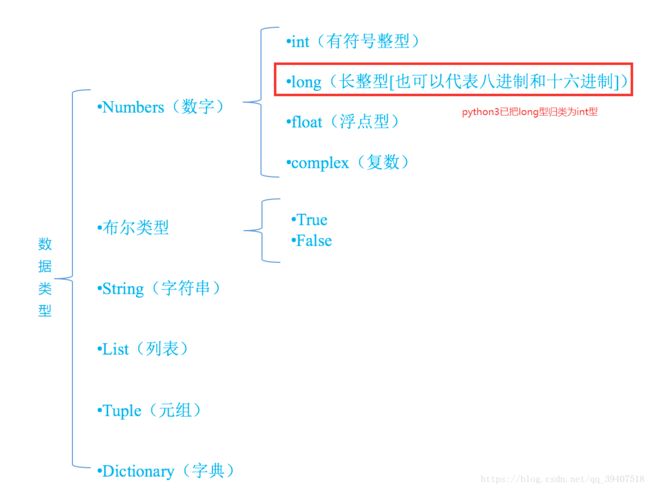python 数据类型(一)
Python运算符包括
- 赋值运算符
- 算术运算符
- 关系运算符
- 逻辑运算符
数字运算符:
关系运算符:
赋值运算符:
逻辑运算符:成员运算符:
身份运算符:

位运算:
运算符优先级:

python的数据类型 (数值+字符串)
In [5]: x = 2 //把 2 赋值给 x
In [6]: y = 'asd' //把 asd 赋值给 y ,注意 当值是字符串的时候需要加 单引号
In [7]: y //查看 y 的值
Out[7]: 'asd'
In [8]: x
Out[8]: 2查看值得类型:
各类语言中假如 java或者c 只要定义一个参数需要先声明这个参数是什么类型! 但是python不需要声明,直接定义即可!
a = 10
b = "hello world"
c = 11.11
print(type(a),type(b),type(c))
输出是:
<class 'int'> <class 'str'> <class 'float'>
整型 字符串 浮点型强制类型转换:
把如上浮点型(float)的11.11强制转换成zh(int)型,后面不管有多少位小数,都会抹去。
print (int(c))
输出就为:
11布尔类型 bool
In [35]: 3 < 5
Out[35]: True //布尔值
In [36]: 1 >= 3
Out[36]: False //布尔值
浮点型 float
In [60]: 3.0/2
Out[60]: 1.5
In [61]: type(3.0/2)
Out[61]: float //浮点型Float代表的数字, ngigits代表的是精度
大的规则是四舍六入
在五的情况上是有所不同
##Python 中关于 round 函数的小坑 点击打开链接
字符串的定义:
字符串或串(String)是由数字、字母、下划线组成的一串字符。
字符串是我们最常用到的,我们用 ' ', " ", "' '"(三重引号(docstring)除了能定义字符串以外,还可以用作注释),都可以定义字符串,特性不可修改;
例子付下:
>>>str2 = 'bbbbbb'
>>>str3 = '''cccccc'''
Python默认是都给我们转换成‘’, 推荐大家使用“ ”
字符串常用的方法:
a = "qwertq"
print(a.find("q")) #从下标0开始查找第一个出现的子字符串,返回结果0
0
print(a.find("a")) #查找不到返回-1
-1
print(a.find("q",1)) #从下标1开始查找第一个出现的子字符串,返回结果5
5
replace()
把字符串中的旧字符串替换成新字符串,返回生成的新字符串。
a = "qwertq" print(a.replace("q","8")) 8wert8
a = " I'm a superman! "
print(a.strip())
I'm a superman!
>>> a1 = "####I'm a superman!#####"
print(a1.strip("#"))
I'm a superman!
将序列中的元素以指定的字符连接生成一个新的字符串,返回新生成的字符串。split() 功能相反
a = "Iamasuperman"
print("-".join(a)) //指定 - 为连接符
I-a-m-a-s-u-p-e-r-m-a-n
= ("n","a","m","e")
print("-".join(a1))
n-a-m-e
print("".join(str1))
name
a = "I'm a superman !"
print(a.split( )) //指定分隔符为空格
["I'm", 'a', 'superman', '!']
print(a.split('a')) //指定分隔符未a
["I'm ", ' superm', 'n !']
字符串格式化方法,使用传入的参数依次替换字符串中的{0}、{1}、{2}、{3}……、{n}。
"这是一只{0},{1}个月大,重{2}千克.".format("猫",5,2)
'这是一只猫,5个月大,重2千克.'
另一种方式:
name = "heweijie"
name2 = "hewj"
name3 = 22
print("hello " + name)
print("%s hahaha %s" %(name, name2))
print("hello %s's your age is %d" %(name, name3))
以下是输出:
hello heweijieheweijie hahaha hewj
hello heweijie's your age is 22
startswith():
检查字符串是否以指定的子字符串开头,如果是则返回True,否则返回False。
a = "I'm a superman!" print(a.startswith("I'm")) True print(a.startswith("you're")) False
endswith()
检查字符串是否以指定的子字符串结尾,如果是则返回True,否则返回False。a = "I'm a superman!"
print(a.endswith("!"))
True
print(a.endswith("man!"))
True
print(a.endswith("man"))
False
字符串取值
a = "a1b2c3d4e5"
print(a[1:4]) //从1开始取, “前开后闭”
1b2
--------
a = "a1b2c3d4e5"
print(a[1:]) //从1取到最后
1b2c3d4e5
----
a = "a1b2c3d4e5"
print(a[1:-1]) //从第一位取到倒数第一, “前开后闭” 最后一位不取
1b2c3d4e
列表 list
列表是一种有序的集合;可以把字符串、数字、字典等任何东西添加到序列,其中的元素无任何关系;
列表中可以随时添加和删除元素;列表自带索引,默认从0开始。
列表的创建是将用 , (逗号) 分隔的不同项 使用 [] (方括号)括起来。
list = [1,2,3,4,5]
list1 = ["I'm","a","superman","!"]
list2 = ["I'm",1,3,"wu"]
要访问列表中的元素,使用索引即可(索引从0开始)。 当索引超出范围时会报错。
list = [1,2,3,4,5]
print(list[0])
1
print(list[4])
5
print(list[5])
Traceback (most recent call last):
File "
IndexError: list index out of range
访问列表中的最后一个元素可以使用-1,倒数第二个则是-2,以此类推。
list = [1,2,3,4,5]
print(list[-1])
5
print(list[-2])
4
print(list[-5])
1
列表常用的方法
list = [1,2,3,4,5]
print(list.index(3))
2
print(list.index(6))
Traceback (most recent call last):
File "" , line 1, in
count( )
统计列表中指定元素出现的个数。返回元素出现个数
list = [1,2,3,4,3,4] print(list.count(3)) 2
list = [1,2,3,4,5] list.append(6) [1, 2, 3, 4, 5, 6]
list = [1,2,3,4,5] #默认删除末尾元素
list.pop())
5
list)
[1, 2, 3, 4]
list.pop(1)) #删除指定位置的元素,该位置为索引位置
2
list)
[1, 3, 4]
insert( )
将指定的对象插入至列表指定的位置。无返回值,会修改列表。
list = [1,2,3,4,5]
list.insert(1,8)
list)
[1, 8, 2, 3, 4, 5]
list.insert(5,10)
list)
[1, 8, 2, 3, 4, 10, 5]
remove( )
移除列表中指定值的第一个匹配项。无返回值,会修改列表。
list = [6, 5, 4, 3, 2, 1]
list.remove(2)
list)
[6, 5, 4, 3, 1]
list1 = ["I'm", 'a', 'superman', '!']
list1.remove("a")
list1)
["I'm", 'superman', '!']
reverse( )
反向列表中的序列。无返回值,会修改列表。
list = [1,2,3,4,5] list.reverse() list) [5, 4, 3, 2, 1]
list = [5,4,3,2,1] list.sort() list) [1, 2, 3, 4, 5] list1 = ["I'm","a","superman","!"] list1.sort() list1) ['!', "I'm", 'a', 'superman']
In [75]: a = 'abcde'
In [76]: a[0]
Out[76]: 'a'
In [77]: a[1]
Out[77]: 'b'
In [78]: a[-1]
Out[78]: 'e'
In [80]: a[0:2] //从头开始 最后一个字符是不包含在内的
Out[80]: 'ab'
In [81]: a[:2] //通常0是省略的
Out[81]: 'ab'
In [82]: a[1:] //从第二个字符开始到最后
Out[82]: 'bcde'input () 交互函数,用来和用户进行交互,输入以后强制转换成字符串(str);用于Python3
In [45]: input("pls input a number: ")
pls input a number: 123
Out[45]: 123
In [46]: input("pls input a number: ")
pls input a number: asd
---------------------------------------------------------------------------
NameError Traceback (most recent call last)
raw_input 函数 ,和input() 一样;只用于Python2
In [47]: raw_input("pls input a number: ")
pls input a number: 234
Out[47]: '234'
In [48]: raw_input("pls input a number: ")
pls input a number: qwe
Out[48]: 'qwe'
//不管你输入的是数字还是字符串,都会当成字符串来处理!元组的创建是将用,(逗号)分隔的不同项使用()(小括号)括起来。 元组创建的时候元素必须且已经定下来了。
t = (1,2,3,4,5)
t)
(1, 2, 3, 4, 5)
t = ()
print(t)
()
type(t)<class 'tuple'>>>> t
只含有1个元素的元组,创建的是时候需要加上,(逗号),否则创建的将不是元组。
t=(1) #该情况下,`()`按照小括号计算
t)
1
type(t))
<class 'int'>
>>> t=("1") #该情况下,`()`按照小括号计算
t)
'1'
type(t))
<class 'str'>
>>> t=(1,) #该情况下,`()`表示元组
t)
(1,)
type(t))
<class 'tuple'>
元组中元素的访问可以按照元素下标访问,也可以按照列表中的-1等访问元组中倒数的元素。
下面介绍列表中可用的方法
index()
查找指定元素在元组中的位置,返回指定元素的索引位置。
t = (1,2,3,4,5) t.index(2)) 1 //索引的位置 t.index(5)) 4
count()
统计元组中指定元素出现的个数,返回元素出现个数。
t = (1,2,3,4,3,4,3) t.count('3')) #元组中为整型,此处为字符串类型 0 t.count('4')) 0 t.count(4)) #元组中整数4出现的次数 2 t.count(3)) 3






